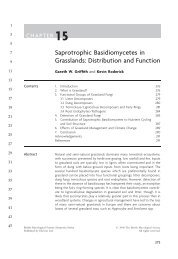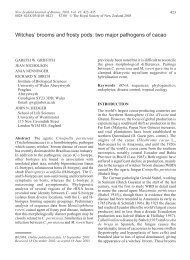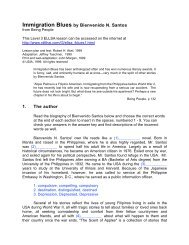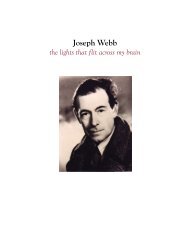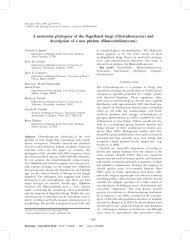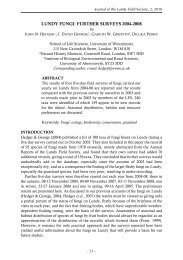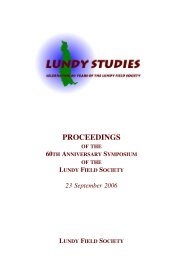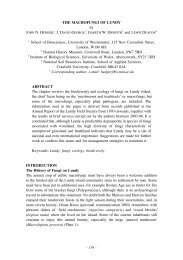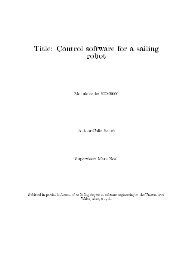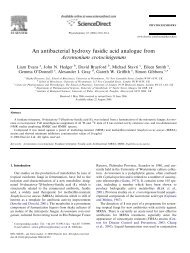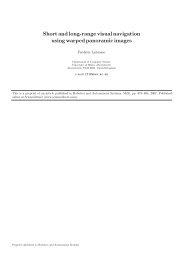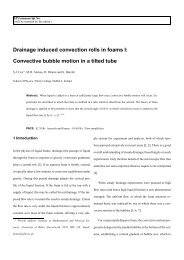Anaerobic rumen fungi
Anaerobic rumen fungi
Anaerobic rumen fungi
You also want an ePaper? Increase the reach of your titles
YUMPU automatically turns print PDFs into web optimized ePapers that Google loves.
Agriculturally Important Microorganisms Vol. II<br />
nd<br />
Dehority BA and Tirabasso PA (1993). Antibiosis between <strong>rumen</strong> bacteria and <strong>fungi</strong>. 22 Biennial Conference on<br />
Rumen Function, Chicago, IL. November 9-11, 6.<br />
Dehority BA and Tirabasso PA (2000). Antibiosis between ruminal bacteria and ruminal <strong>fungi</strong>. Appl Environ<br />
Microbiol 66: 2921-2927<br />
Dey A, Sehgal JP, Puniya AK and Singh K (2004). Influence of an anaerobic fungal culture (Orpinomyces sp.)<br />
administration on growth rate, ruminal fermentation and nutrient digestion in calves. Asian-Aus J Anim Sci 17:<br />
733-884<br />
Elliot R, Ash AJ, Calderon-Cortes F, Norton BW and Bauchop T (1987). The influence of anaerobic <strong>fungi</strong> on <strong>rumen</strong><br />
volatile fatty acid concentrations in vivo. J Agric Sci 109: 13-17.<br />
Engels FM and Brice RE (1985). A barrier covering lignified cell walls of barley straw that resist access by <strong>rumen</strong><br />
microorganisms. Curr Microbiol 12: 217-224.<br />
Faichney GJ, Poncet C, Lassalas B, Jouany JP, Millet L, Dore J and Brownlee AG (1997). Effects of concentrates in a hay<br />
diet on the contribution of anaerobic <strong>fungi</strong>, protozoa and bacteria to nitrogen in <strong>rumen</strong> and duodenal digesta in<br />
sheep. Anim Feed Sci Tech 64: 193-213.<br />
Fliegerova K, Hodrova B and Voigt K (2004). Classical and molecular approaches as a powerful tool for the<br />
characterization of <strong>rumen</strong> polycentric <strong>fungi</strong>. Folia Microbiol 49: 157-164.<br />
Fonty G and Grenet E (1994). Effects of diet on the fungal population of the digestive tract of ruminants. In: Mountfort<br />
DO and Orpin CG (eds). <strong>Anaerobic</strong> Fungi: Biology, Ecology and Function. New York: Marcel Dekker, pp 229-<br />
239.<br />
Fonty G and Joblin KN (1991). Rumen anaerobic <strong>fungi</strong>: their role and interaction in other <strong>rumen</strong> microorganisms in<br />
relation to fibre digestion. In: Tsuda T, Sasaki Y and Kawashima R (eds). Physiological aspect of digestion<br />
metabolism in ruminants. San Diego: Academic press, pp 655-680<br />
Fonty G, Gouet Ph, Jouany JP and Senand J (1987). Establishment of the microflora and anaerobic <strong>fungi</strong> in the <strong>rumen</strong><br />
of lambs. J Gen Microbiol 133: 1835-1943.<br />
France J, Theodorou MK and Davies D (1990). Use of zoospore concentration and life cycle parameters in determining<br />
the population of anaerobic <strong>fungi</strong> in the <strong>rumen</strong> ecosystem. J Theor Bio 147. 413-422.<br />
Gaillard-Martinie B, Breton A, Dusser M and Julliand V (1995). Piromyces citronii sp. nov, a strictly anaerobic fungus<br />
from the equine caecum: a morphological, metabolic and ultrastructural study. FEMS Microbiol Lett 130: 321-<br />
326.<br />
Gilkes NR, Henrissat B and Kilburn DG (1991). Domains in microbial -1,4–glucanases: sequence conservation,<br />
function and enzyme families. Microbiol Rev 55: 303-315.<br />
Gold JJ, Heath IB and Bauchop T (1988). Ultrastructural description of a new chytrid genus of caecum anaerobe,<br />
Caecomyces equi gen. nov. sp. nov, assigned to the Neocallimasticaceae. Biosystems 21.403-415.<br />
Gordon GLR (1990). Selection of anaerobic <strong>fungi</strong> for better fibre degradation in the <strong>rumen</strong>. In: Akin DE, Ljungdahl<br />
LG, Wilson JR and Harris PJ (eds). Microbial and plant opportunities to improve lignocellulose utilization by<br />
ruminants. New York: Elsevier, pp 301-309.<br />
Gordon GLR and Phillips MW (1989). Degradation and utilization of cellulose and straw by three different anaerobic<br />
<strong>fungi</strong> from the ovine <strong>rumen</strong>. Appl Environ Microbiol 55: 1703-1710.<br />
Gordon GLR and Phillips MW (1992). Extracellular pectin lyase produced by Neocallimastix sp. LM1, a <strong>rumen</strong><br />
anaerobic fungus. Lett Appl Microbiol 15: 113-115.<br />
Gordon GLR and Phillips MW (1993). Removal of anaerobic <strong>fungi</strong> from the <strong>rumen</strong> of sheep by chemical treatment<br />
and the effect on feed consumption and in vivo fibre digestion. Lett Appl Microbiol 17: 220-223.<br />
Gordon GLR and Phillips MW (1998). The role of anaerobic gut <strong>fungi</strong> in ruminants. Nutr Res Rev 11: 1-36.<br />
Grenet E, Breton A, Barry P and Fonty G (1989). Rumen anaerobic <strong>fungi</strong> and plant substrate colonization as affected<br />
by diet composition. Anim Feed Sci Tech 26: 55-70.<br />
Gulati SK, Ashes JR and Gordon GLR (1990). Comparative digestibility of sulphur amino acids in <strong>rumen</strong> bacteria and<br />
fungal proteins by sheep. Proc Nutr Society Aust 15: 128-131.<br />
Gulati SK, Ashes JR, Connel PJ and Gordon GLR (1989). Amino acid profiles of anaerobic <strong>rumen</strong> <strong>fungi</strong>. Proc Nutr<br />
Society Aust 14: 134.<br />
Harhangi HR (2002). Molecular studies of (hemi-) cellulolytic enzymes from the anaerobic fungus Piromyces sp. E2.<br />
PhD dissertation. University of Nijmegen, Nijmegen, The Netherlands.<br />
Heath IB, Bauchop T and Skipp RA (1983). Assignment of the <strong>rumen</strong> anaerobe Neocallimastix frontalis to the<br />
388



